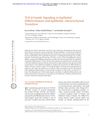Search
forLearn
5 / 6 resultslearn Stem Cell Factor
learn Osteopontin
signaling protein that, when suppressed, may grow hair by reducing inflammation and stem cell loss
learn Overview
learn Hair Multiplication
extract, clone, and reinsert your own hair cells
Research
5 / 1000+ resultsresearch Wnt Signaling Induces Epithelial Differentiation During Cutaneous Wound Healing
Wnt signaling can improve skin healing by promoting epithelial growth.

research TGF-β Family Signaling in Epithelial Differentiation and Epithelial-Mesenchymal Transition
The TGF-β family helps control how cells change and move, affecting skin, hair, and organ development.
research Epithelial Differentiation of Human Adipose-Derived Stem Cells Undergoing Three-Dimensional Cultivation with Collagen Sponge Scaffold via an Indirect Co-Culture Strategy
Using a collagen sponge scaffold helps stem cells become more like skin cells.
research Wnt-10b Secreted From Lymphocytes Promotes Differentiation of Skin Epithelial Cells
Wnt-10b helps skin cells and hair grow.
research Suprabasal Change and Subsequent Formation of Disulfide-Stabilized Homo- and Hetero-Dimers of Keratins During Esophageal Epithelial Differentiation
Keratins K4 and K13 form stable dimers in mature esophageal cells, aiding cell stability.
Community Join
5 / 32 resultscommunity Molecular mechanisms triggered by Micronedlling -- Intersting Publication to better understand Dermarolling
This post and conversation are about the molecular mechanisms triggered by microneedling, specifically its effects on inflammation, tissue remodeling, epithelial proliferation, differentiation, and collagen synthesis. The discussion highlights the potential benefits of microneedling for hair loss treatment.
community Unofficial Dermapen/Roller Guide
Treatments for hair loss, including microneedling (dermarolling and dermapen) and the use of minoxidil, finasteride, and RU58841. It provides detailed information about cost and usage of the various treatments, as well as potential side effects.

community Minoxidil Response Bottlenecks: Why Sulfation and Transport Matter (And Where Tretinoin Fits In)
Minoxidil's effectiveness is limited by the need for sulfation and proper transport to hair follicles, with tretinoin potentially enhancing its effects by promoting enzyme activity and keratinocyte differentiation. Tretinoin may improve minoxidil's response by boosting the expression of necessary enzymes and transporters.

community Compressed part of research of theory of androgenic/anabolitic balance. AGA h-responders analytic. Theory of physio-metabolitic method of anti AGA treatment
The treatment for androgenetic alopecia involves using finasteride and minoxidil with intense exercise and cold exposure to boost metabolism and reduce androgenic effects, potentially leading to hair regrowth. This approach may activate biological pathways for improved hair and overall health.
community TWIST-1 and the cure: Is it really that easy?
TWIST-1 gene's role in hair loss and potential as a treatment target. Inhibiting TWIST-1 may prolong hair growth and reduce hair follicle sensitivity to DHT.